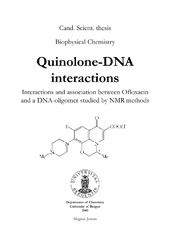Quinolone-DNA interactions. Interactions and association between Ofloxacin and a DNA-oligomer studied by NMR methods
Master thesis
Permanent lenke
https://hdl.handle.net/1956/4304Utgivelsesdato
2003Metadata
Vis full innførselSamlinger
- Department of Chemistry [433]
Sammendrag
The first part of this thesis examines Ofloxacin (Oflo), a second-generation quinolone, by applying 1D 1H NMR. Molecular dynamics, stacking conditions and the self-diffusion constant were investigated. No certain conclusion could be drawn concerning molecular dynamics. It appears like hindering of the ring-rotation initiated by hydrogen bonding arising from the F9 and O1 is the reason for the coalescence observed in the 1H NMR spectrum. Slow inversion of the methylpiperazine ring cannot be excluded. It was confirmed that no stacking occurs in the concentration range 1 - 6 mM and the self-diffusion constant was determined to be 4.33 (± 0.07) * 10-10 m2s-1. The self-diffusion constant appears to depend on concentration, but the dependency was within the limits of error in the concentration range used in this thesis, and it has therefore been regarded as independent of concentration. In the second part of this thesis the 1D 1H and 2D NOESY NMR spectra of a palindromic decamer T1A2T3G4G5C6C7A8T9A10 (named GGCC) were investigated and the self-diffusion constant calculated to be 1.33 (±0.07) * 10-10m2s-1. The third part of this thesis combines GGCC and Oflo in a series of titrations. 1D 1H NMR spectra and diffusion constants were obtained at 11 different Oflo:GGCC ration. A NOESY spectrum was obtained for the last titration. A model for the interaction between Ofloxacin and GGCC has been proposed. This model postulates both minor/major groove and intercalation interactions. The minor/major groove interaction occurs at all concentration levels, the intercalation is initiated at a Oflo:GGCC ratio of 1. The minor/major groove interaction and the intercalation appear to be linked. The results fail to exclude other models of interaction. The only certain conclusion may therefore be that intercalation takes place, but there appears to be more than one interaction mode.
Utgiver
The University of BergenOpphavsrett
The authorCopyright the author. All rights reserved
